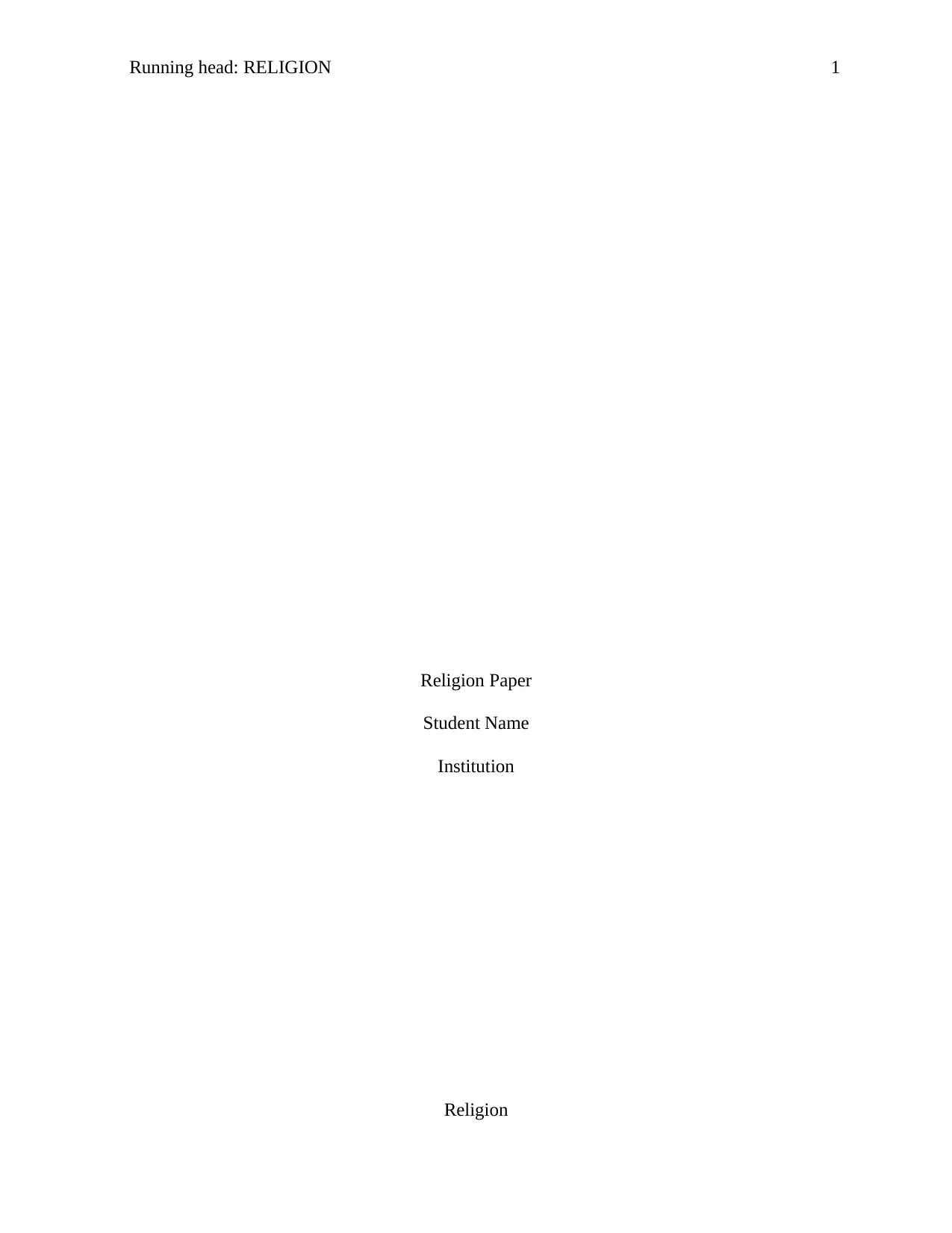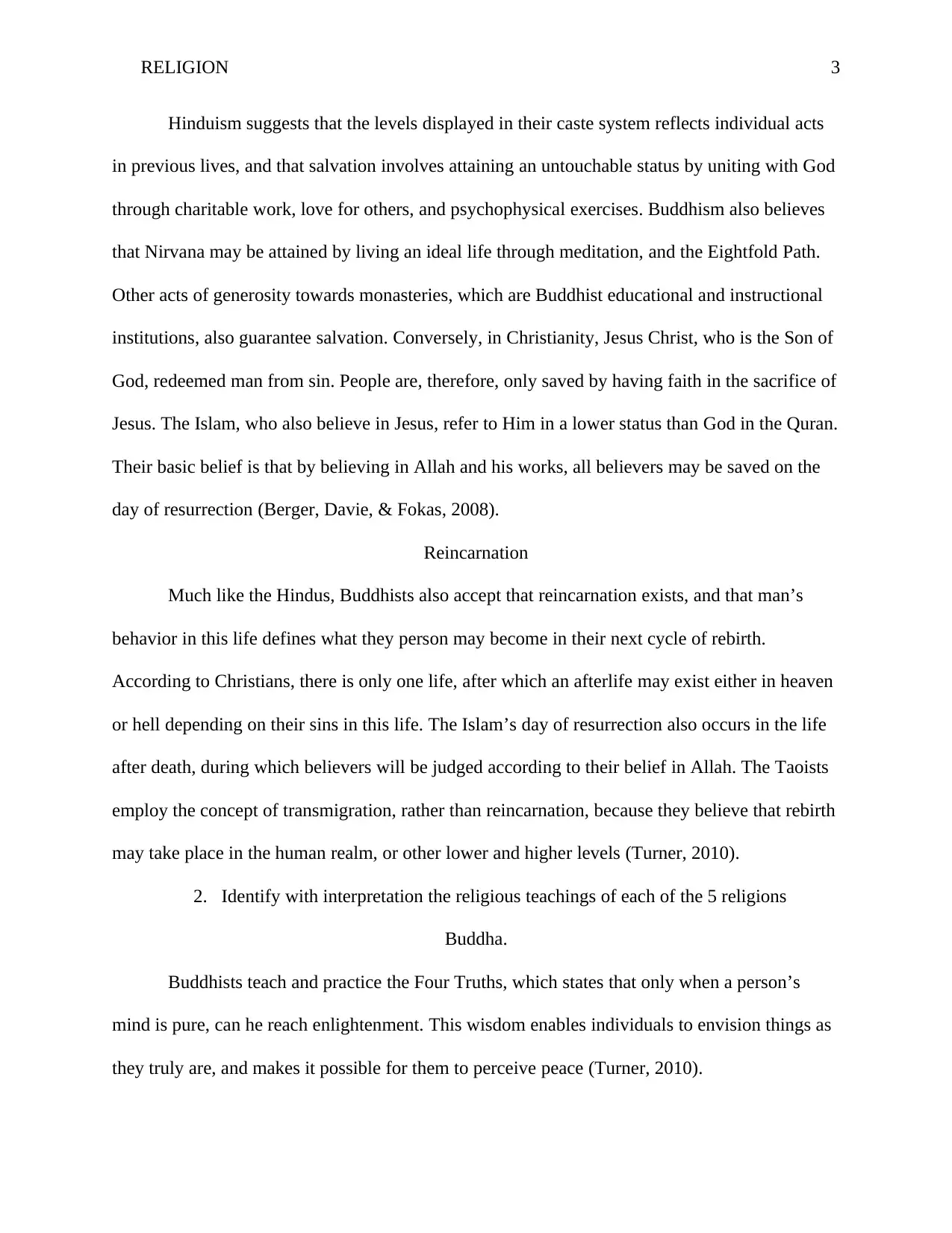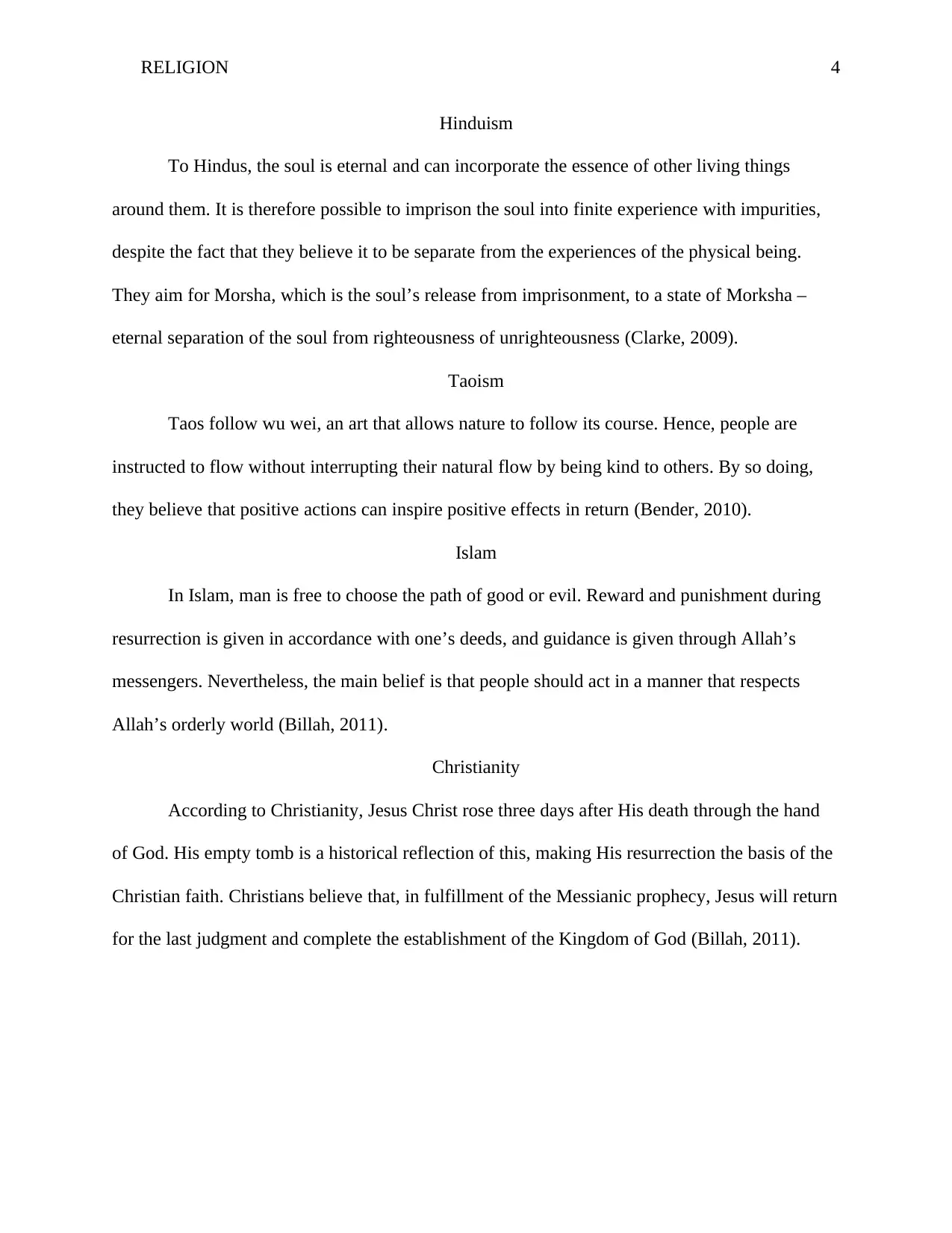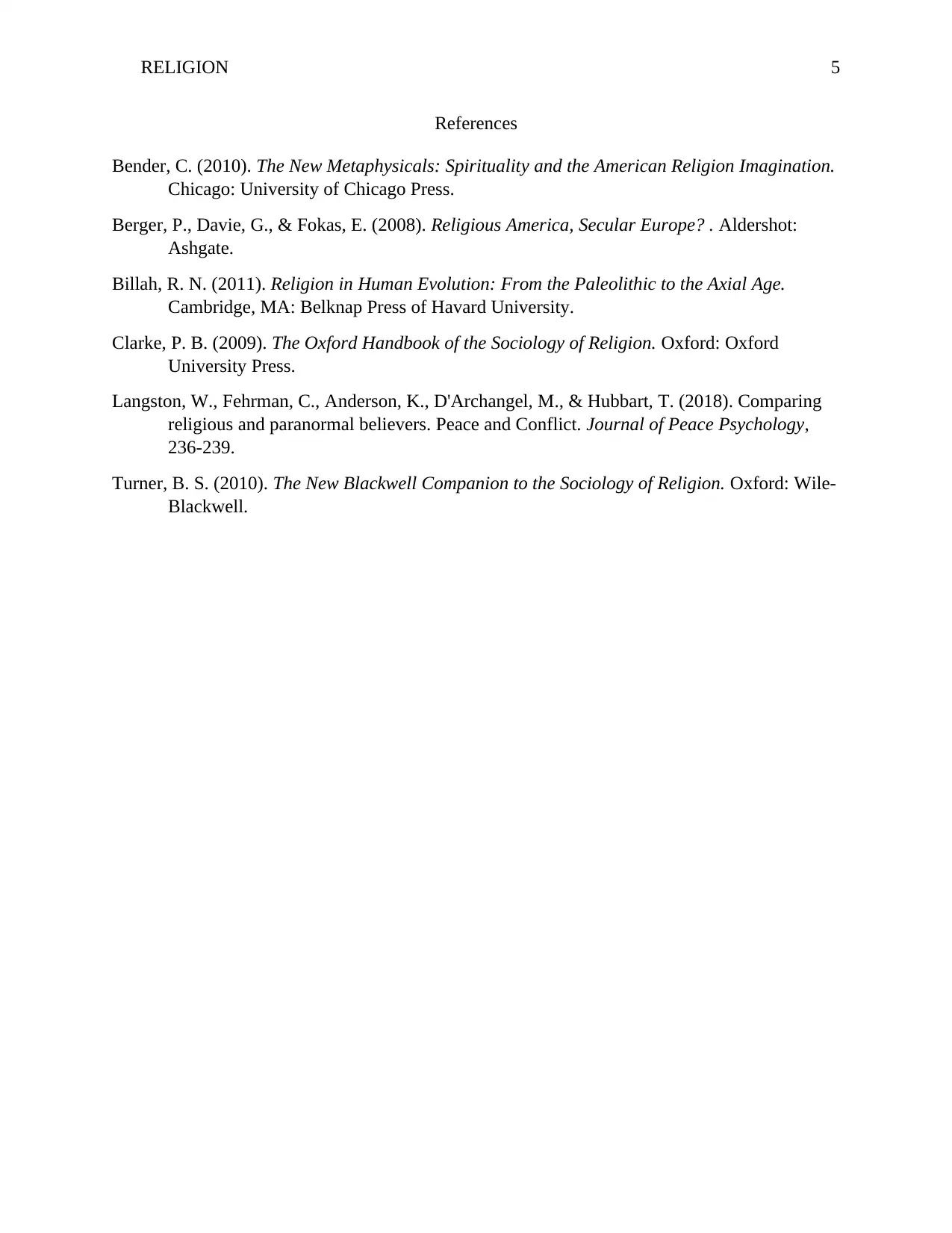REL101: Comparative Analysis of Five Religions - Semester 1, 2024
VerifiedAdded on 2023/01/13
|5
|1171
|2
Essay
AI Summary
This essay provides a comparative analysis of five major world religions: Hinduism, Buddhism, Taoism, Islam, and Christianity. The paper begins by contrasting their origins, highlighting the differences in how their practices and beliefs came about. It then delves into their views of God, contrasting the polytheistic nature of Hinduism with the monotheistic perspectives of Christianity and Islam, as well as the non-theistic approaches of Buddhism and Taoism. The essay further explores each religion's path to salvation, examining the concepts of reincarnation, the Eightfold Path, and the role of faith and good deeds. The essay also interprets the religious teachings of each of the five religions. The essay uses various sources to support its arguments. Overall, the essay provides a comprehensive overview of these religions, offering insights into their core tenets and practices.

Running head: RELIGION 1
Religion Paper
Student Name
Institution
Religion
Religion Paper
Student Name
Institution
Religion
Paraphrase This Document
Need a fresh take? Get an instant paraphrase of this document with our AI Paraphraser

RELIGION 2
1. Compare and contrast the Five Religions. Describe, and Give Your Comments
Origin
The disparity between Hinduism and Christianity, is that Christians believe that practices
were revealed to one particular person at a specific time and place by God. The Islam religion
also hold a similar belief. However, in Hinduism, their practices came about as a realization of
truths through different individuals across different periods of time. On the other hand,
Buddhism originated from Hinduism when the beliefs of the founder, Siddhartha Guatama,
became the backbone of the religious practices of Buddhaism (Clarke, 2009).
View of God
Hindu is a polytheistic religion known commonly for wrathful gods centered on a caste
system. They, however, also believe in a supreme being known as Brahma, who is the ultimate
decision maker. Conversely, Buddhism does not believe in gods since its practices attests to the
belief that man alone can transition from good to evil if they simply follow the Eightfold Path of
the Middle Way. Similarly, Taoism does not believe in gods, and, therefore, seek solutions to
any of their problems using inner meditation and outer adherence to their life principles
(Langston, Fehrman, Anderson, D'Archangel, & Hubbart, 2018). Christianity is a monotheistic
religion since it believes, without question, in Jesus as the son of God, and also as part of the
Holy Trinity. Their beliefs suggest that He is equally God, together with God the Father, and
God the Holy Spirit. Additionally, the Hindu believe in a Trinitarian view of God, whereas the
Islam preach that there exists only one supernatural being -- Allah, the maker, creator, the life
giver, and the bringer of death (Billah, 2011).
Salvation
1. Compare and contrast the Five Religions. Describe, and Give Your Comments
Origin
The disparity between Hinduism and Christianity, is that Christians believe that practices
were revealed to one particular person at a specific time and place by God. The Islam religion
also hold a similar belief. However, in Hinduism, their practices came about as a realization of
truths through different individuals across different periods of time. On the other hand,
Buddhism originated from Hinduism when the beliefs of the founder, Siddhartha Guatama,
became the backbone of the religious practices of Buddhaism (Clarke, 2009).
View of God
Hindu is a polytheistic religion known commonly for wrathful gods centered on a caste
system. They, however, also believe in a supreme being known as Brahma, who is the ultimate
decision maker. Conversely, Buddhism does not believe in gods since its practices attests to the
belief that man alone can transition from good to evil if they simply follow the Eightfold Path of
the Middle Way. Similarly, Taoism does not believe in gods, and, therefore, seek solutions to
any of their problems using inner meditation and outer adherence to their life principles
(Langston, Fehrman, Anderson, D'Archangel, & Hubbart, 2018). Christianity is a monotheistic
religion since it believes, without question, in Jesus as the son of God, and also as part of the
Holy Trinity. Their beliefs suggest that He is equally God, together with God the Father, and
God the Holy Spirit. Additionally, the Hindu believe in a Trinitarian view of God, whereas the
Islam preach that there exists only one supernatural being -- Allah, the maker, creator, the life
giver, and the bringer of death (Billah, 2011).
Salvation

RELIGION 3
Hinduism suggests that the levels displayed in their caste system reflects individual acts
in previous lives, and that salvation involves attaining an untouchable status by uniting with God
through charitable work, love for others, and psychophysical exercises. Buddhism also believes
that Nirvana may be attained by living an ideal life through meditation, and the Eightfold Path.
Other acts of generosity towards monasteries, which are Buddhist educational and instructional
institutions, also guarantee salvation. Conversely, in Christianity, Jesus Christ, who is the Son of
God, redeemed man from sin. People are, therefore, only saved by having faith in the sacrifice of
Jesus. The Islam, who also believe in Jesus, refer to Him in a lower status than God in the Quran.
Their basic belief is that by believing in Allah and his works, all believers may be saved on the
day of resurrection (Berger, Davie, & Fokas, 2008).
Reincarnation
Much like the Hindus, Buddhists also accept that reincarnation exists, and that man’s
behavior in this life defines what they person may become in their next cycle of rebirth.
According to Christians, there is only one life, after which an afterlife may exist either in heaven
or hell depending on their sins in this life. The Islam’s day of resurrection also occurs in the life
after death, during which believers will be judged according to their belief in Allah. The Taoists
employ the concept of transmigration, rather than reincarnation, because they believe that rebirth
may take place in the human realm, or other lower and higher levels (Turner, 2010).
2. Identify with interpretation the religious teachings of each of the 5 religions
Buddha.
Buddhists teach and practice the Four Truths, which states that only when a person’s
mind is pure, can he reach enlightenment. This wisdom enables individuals to envision things as
they truly are, and makes it possible for them to perceive peace (Turner, 2010).
Hinduism suggests that the levels displayed in their caste system reflects individual acts
in previous lives, and that salvation involves attaining an untouchable status by uniting with God
through charitable work, love for others, and psychophysical exercises. Buddhism also believes
that Nirvana may be attained by living an ideal life through meditation, and the Eightfold Path.
Other acts of generosity towards monasteries, which are Buddhist educational and instructional
institutions, also guarantee salvation. Conversely, in Christianity, Jesus Christ, who is the Son of
God, redeemed man from sin. People are, therefore, only saved by having faith in the sacrifice of
Jesus. The Islam, who also believe in Jesus, refer to Him in a lower status than God in the Quran.
Their basic belief is that by believing in Allah and his works, all believers may be saved on the
day of resurrection (Berger, Davie, & Fokas, 2008).
Reincarnation
Much like the Hindus, Buddhists also accept that reincarnation exists, and that man’s
behavior in this life defines what they person may become in their next cycle of rebirth.
According to Christians, there is only one life, after which an afterlife may exist either in heaven
or hell depending on their sins in this life. The Islam’s day of resurrection also occurs in the life
after death, during which believers will be judged according to their belief in Allah. The Taoists
employ the concept of transmigration, rather than reincarnation, because they believe that rebirth
may take place in the human realm, or other lower and higher levels (Turner, 2010).
2. Identify with interpretation the religious teachings of each of the 5 religions
Buddha.
Buddhists teach and practice the Four Truths, which states that only when a person’s
mind is pure, can he reach enlightenment. This wisdom enables individuals to envision things as
they truly are, and makes it possible for them to perceive peace (Turner, 2010).
⊘ This is a preview!⊘
Do you want full access?
Subscribe today to unlock all pages.

Trusted by 1+ million students worldwide

RELIGION 4
Hinduism
To Hindus, the soul is eternal and can incorporate the essence of other living things
around them. It is therefore possible to imprison the soul into finite experience with impurities,
despite the fact that they believe it to be separate from the experiences of the physical being.
They aim for Morsha, which is the soul’s release from imprisonment, to a state of Morksha –
eternal separation of the soul from righteousness of unrighteousness (Clarke, 2009).
Taoism
Taos follow wu wei, an art that allows nature to follow its course. Hence, people are
instructed to flow without interrupting their natural flow by being kind to others. By so doing,
they believe that positive actions can inspire positive effects in return (Bender, 2010).
Islam
In Islam, man is free to choose the path of good or evil. Reward and punishment during
resurrection is given in accordance with one’s deeds, and guidance is given through Allah’s
messengers. Nevertheless, the main belief is that people should act in a manner that respects
Allah’s orderly world (Billah, 2011).
Christianity
According to Christianity, Jesus Christ rose three days after His death through the hand
of God. His empty tomb is a historical reflection of this, making His resurrection the basis of the
Christian faith. Christians believe that, in fulfillment of the Messianic prophecy, Jesus will return
for the last judgment and complete the establishment of the Kingdom of God (Billah, 2011).
Hinduism
To Hindus, the soul is eternal and can incorporate the essence of other living things
around them. It is therefore possible to imprison the soul into finite experience with impurities,
despite the fact that they believe it to be separate from the experiences of the physical being.
They aim for Morsha, which is the soul’s release from imprisonment, to a state of Morksha –
eternal separation of the soul from righteousness of unrighteousness (Clarke, 2009).
Taoism
Taos follow wu wei, an art that allows nature to follow its course. Hence, people are
instructed to flow without interrupting their natural flow by being kind to others. By so doing,
they believe that positive actions can inspire positive effects in return (Bender, 2010).
Islam
In Islam, man is free to choose the path of good or evil. Reward and punishment during
resurrection is given in accordance with one’s deeds, and guidance is given through Allah’s
messengers. Nevertheless, the main belief is that people should act in a manner that respects
Allah’s orderly world (Billah, 2011).
Christianity
According to Christianity, Jesus Christ rose three days after His death through the hand
of God. His empty tomb is a historical reflection of this, making His resurrection the basis of the
Christian faith. Christians believe that, in fulfillment of the Messianic prophecy, Jesus will return
for the last judgment and complete the establishment of the Kingdom of God (Billah, 2011).
Paraphrase This Document
Need a fresh take? Get an instant paraphrase of this document with our AI Paraphraser

RELIGION 5
References
Bender, C. (2010). The New Metaphysicals: Spirituality and the American Religion Imagination.
Chicago: University of Chicago Press.
Berger, P., Davie, G., & Fokas, E. (2008). Religious America, Secular Europe? . Aldershot:
Ashgate.
Billah, R. N. (2011). Religion in Human Evolution: From the Paleolithic to the Axial Age.
Cambridge, MA: Belknap Press of Havard University.
Clarke, P. B. (2009). The Oxford Handbook of the Sociology of Religion. Oxford: Oxford
University Press.
Langston, W., Fehrman, C., Anderson, K., D'Archangel, M., & Hubbart, T. (2018). Comparing
religious and paranormal believers. Peace and Conflict. Journal of Peace Psychology,
236-239.
Turner, B. S. (2010). The New Blackwell Companion to the Sociology of Religion. Oxford: Wile-
Blackwell.
References
Bender, C. (2010). The New Metaphysicals: Spirituality and the American Religion Imagination.
Chicago: University of Chicago Press.
Berger, P., Davie, G., & Fokas, E. (2008). Religious America, Secular Europe? . Aldershot:
Ashgate.
Billah, R. N. (2011). Religion in Human Evolution: From the Paleolithic to the Axial Age.
Cambridge, MA: Belknap Press of Havard University.
Clarke, P. B. (2009). The Oxford Handbook of the Sociology of Religion. Oxford: Oxford
University Press.
Langston, W., Fehrman, C., Anderson, K., D'Archangel, M., & Hubbart, T. (2018). Comparing
religious and paranormal believers. Peace and Conflict. Journal of Peace Psychology,
236-239.
Turner, B. S. (2010). The New Blackwell Companion to the Sociology of Religion. Oxford: Wile-
Blackwell.
1 out of 5
Related Documents
Your All-in-One AI-Powered Toolkit for Academic Success.
+13062052269
info@desklib.com
Available 24*7 on WhatsApp / Email
![[object Object]](/_next/static/media/star-bottom.7253800d.svg)
Unlock your academic potential
Copyright © 2020–2025 A2Z Services. All Rights Reserved. Developed and managed by ZUCOL.





